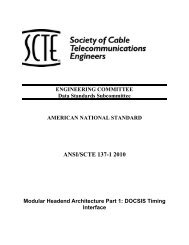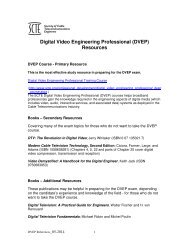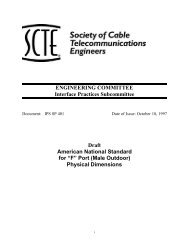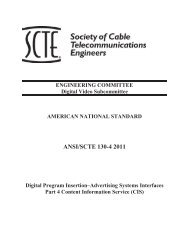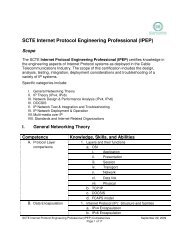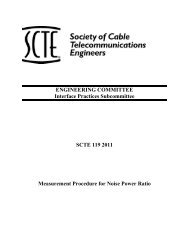SCTE IPS Template, Rev 2
SCTE IPS Template, Rev 2
SCTE IPS Template, Rev 2
- No tags were found...
You also want an ePaper? Increase the reach of your titles
YUMPU automatically turns print PDFs into web optimized ePapers that Google loves.
7.0 APPENDIX A: A DERIVATION OF CROSS MODULATION.In this appendix the derivations of the classical AM-XMOD expression and an expanded crossmodulation expression, that embodies both an AM-XMOD and a PM-XMOD component, willbe outlined separately. A thorough discussion of the consequences of each of the expressionsobtained in the analysis will be presented. Most importantly, the consequences in the practicalmeasurement of the AM-XMOD level will be detailed for each case.As is well known, active devices used as building blocks for amplifiers are composed ofsemiconductor junctions. These junctions control the transport of charge (i.e. current) throughthe device and provide the fundamental mechanism for power gain. The nonlinear(mathematical) models for these junctions and their effects on the signals being amplified areoften derived for two important cases: the ‘static’ case and the ‘dynamic’ case. It is these twocases that give rise to the two components of cross modulation.Specifically, a simplified expression for the AM-XMOD is derived from consideration of thestatic case. Consideration of the dynamic case results in a more complex derivation of crossmodulation, which gives rise to a more complex expression for AM-XMOD. Therefore, thereare differences in the expression for the AM-XMOD in the dynamic case, from the static case.This difference conveys possible measurable effects in the level of the AM-XMOD componentand can determine the ultimate repeatability of the measurement.The more complex derivation of the general expression for cross modulation, from considerationof the dynamic case, leads to the added result that an additional component manifests itself in theform of Phase Modulation, upon the carrier signal, even though that particular’s carrier isunmodulated. Although this effect is on the carrier phase, the form is similar to the (morecomplex) expression for the AM-XMOD component and results in additional spectral sidebandenergy. This additional energy leads to consequences that can change the measured level of theAM-XMOD component, under certain conditions. Simply stated, “the existence of PM-XMODcan lead to a change in the measured level of the AM-XMOD.” This important theoretical resultwill also be presented in this appendix.The treatment of the two cases (i.e. the ‘static’ and the ‘dynamic’) and the perceived effects, arebased upon different assumptions about how the device behaves physically. It is theseassumptions that are important in determining which case is pertinent in the practical applicationof the measurement.10



